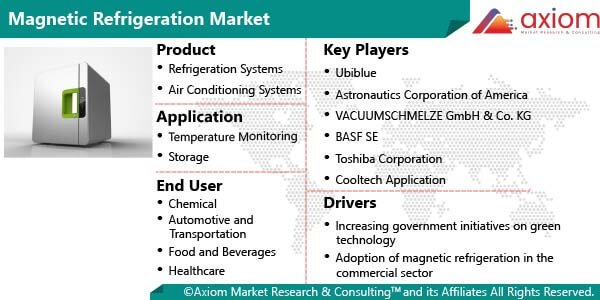Magnetic refrigeration is based on the principle of Magnetocaloric Effect (MCE). Magnetocaloric effect is a phenomenon where Magnetocaloric materials gets heated up when they are immersed in the magnetic field and cool down when removed from it, almost instantly. Magnetic refrigeration is safer, compact, and quieter and it is higher cooling efficient as compared to the traditional gas compression refrigeration. A series of the magnetization-demagnetization cycles to the magneto caloric alloys is applied in a magnetic refrigeration system.
Magnetic refrigeration technology is energy efficient and environmentally friendly and reduces operational and maintenance costs as it does not require any refrigerants or components such as a compressor. Government support to develop magnetic refrigeration technology and strict regulations to reduce the use of refrigerants harmful to the environment are some important factors expected to drive market growth.
Magnetic Refrigeration Market Outlook
Some of the key driving factors of the magnetic refrigeration market are increasing government initiatives on green technology, low maintenance costs, compact design, and high energy efficiency offered by magnetic refrigeration technology. Furthermore, increasing global concerns to reduce polluting emissions, especially gases that are harmful to the Earth’s environment, has created the need for some alternative source for cooling purposes. Magnetic refrigeration offers a green cooling technology that would enable manufacturers to reduce their carbon footprint. Magnetic refrigeration-based products do not use refrigerants such as chlorofluorocarbons (CFCs), hydro chlorofluorocarbons (HCFCs), and other gases such as ammonia and chlorine, thereby reducing their direct gas emissions.
Presently, the majority of refrigerants available in the market have a high global warming potential (GWP), and especially those releasing chlorine largely lead to the depletion of the ozone layer. Refrigerants with low GWP, such as ammonia and CO2, have been introduced but have safety-related issues such as flammability, toxicity, pressure, and temperature limitations.
Magnetic Refrigeration Market COVID-19 Impact
The global pandemic of Coronavirus (COVID-19) has triggered stock market instability, tight border controls, and worldwide lockdown, leading the chemical industry, as well as large companies and governments, to restock supply chains. The whole world is experiencing severe impact on social and financial sectors, and all global industries are facing challenges during the COVID-19 pandemic. Rising support from governments and several companies can help in the fight against this highly contagious disease. There are some industries that are struggling and some are thriving. Overall, almost every sector is anticipated to be impacted by the pandemic.
Magnetic Refrigeration Market Segmental Analysis
The global magnetic refrigeration market is segmented by product, application and geography. Based on different products, the global magnetic refrigeration market can be segmented as cryogenic refrigerators, display cases, ice making machineries, beverages refrigeration, air conditioning, chillers, heat pump, and others. Based on application, the global magnetic refrigeration market can be classified as domestic refrigeration, commercial refrigeration, refrigerated transportation and logistics, automotive HVAC, industrial refrigeration, food and beverages processing industries, healthcare, and others. Magnetic refrigeration for commercial applications is projected to be commercialized by 2023 with products such as cabinet displays and beverage coolers. Many players are targeting this application to commercialize their products. Companies such as Ubiblue are already testing these products with retail partners and are expected to generate recognizable revenue by 2022. Increasing efforts of players to develop and offer various products based on the magnetic refrigeration technology for the commercial application is a major driving factor of the market.
Magnetic Refrigeration Market Regional Trends
The magnetic refrigeration market is segmented on the basis of following geographies are North America, Europe, Asia Pacific and Rest of the World. Europe is expected to be a booming market for EOR technology as a number of upcoming projects are there in Russia. The imposition of bans on the use of conventional refrigerants is expected to contribute to the growing market for magnetic refrigeration as it gradually replaces the existing technology used for cooling. The European Union’s initiative to check global warming and ozone depletion by banning high GWP refrigerants will be one of the major drivers for the growth of magnetic refrigeration in Europe.
Magnetic Refrigeration Market Players
The major key vendors in Magnetic Refrigeration market include, Astronautics Corporation Of America, Basf Se, Camfridge Ltd, Ccs SA, Cemafroid, Eramet, General Engineering & Research, Haier Smart Home Co., Ltd, Kirsch, Kiutra, Magnotherm Solutions, Millipore Sigma, Samsung Electronics Co., Ltd, Tcs Micropumps Ltd, Toshiba Corporation, Ubiblue, Vacuumschmelze Gmbh & Co. Kg, Vcu Innovation Gateway and Whirlpool Corporation. The key vendors of Magnetic Refrigeration prefer agreements, joint ventures, contracts and partnership strategies and mergers & acquisitions to gather a larger share in the market. These players have taken various initiatives & R&D efforts to develop magnetic refrigeration technology. For instance, GE Appliances, a Haier company, and the Office of Energy & Renewable Energy (US) collaborated on a project to successfully harness the Magneto Caloric Effect (MCE) at the Oak Ridge National Laboratory (US). The project was initiated in June 2017 and planned to finish by June 2020, with the outcome of achieving cooling through MCE.











